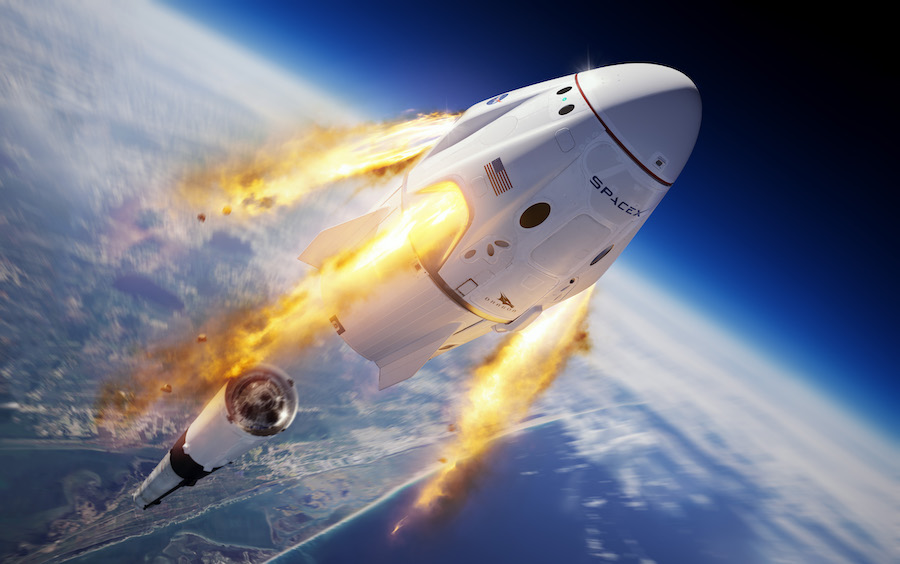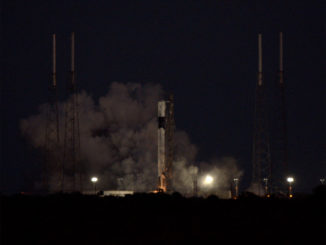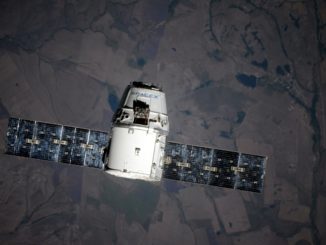
SpaceX will sacrifice a Falcon 9 rocket Sunday in a fiery test a minute-and-a-half after liftoff from Florida’s Space Coast to prove the company’s Crew Dragon spacecraft can safely push astronauts away from a failing launch vehicle, simulating a daring maneuver that would only be attempted on a piloted mission during an in-flight emergency.
The launch escape demonstration could be a spectacle for local residents, rocket fans and enthusiasts along the Space Coast, assuming clear skies and good visibility, according to SpaceX.
While the Crew Dragon capsule — flying without astronauts on Sunday’s test — fires away from the top of the Falcon 9 rocket, the booster itself is expected to tumble and break apart, possibly in a fireball visible from the ground.
The purpose of the test — the final planned demonstration of a full-scale Crew Dragon before NASA astronauts fly it int orbit — is to validate the ship’s launch escape system. Abort rockets mounted around the circumference of the capsule would activate to rapidly carry the spaceship and its astronaut crew away from an emergency during launch on a Falcon 9 rocket, such as a booster failure or explosion.
“On launch day (with crews), we’re really hoping for it not to be exciting,” said Kathy Lueders, manager of NASA’s commercial crew program. “I will tell you (Sunday) will be an exciting day. We are purposely failing a launch vehicle to make sure that our abort system on the spacecraft that we’ll be flying for our crews works.”
The Crew Dragon’s eight liquid-fueled SuperDraco escape engines will ignite around 84 seconds after liftoff on top of a Falcon 9 rocket from pad 39A, soon after the point in the launch sequence where the booster and capsule experience the most extreme aerodynamic pressures.
The abort thrusters will generate nearly 130,000 pounds of thrust, pushing the gumdrop-shaped crew capsule away from the top of the Falcon 9 with an acceleration of up to to 4Gs.
The six-hour test window opens at 8 a.m. EST (1300 GMT) Sunday. SpaceX called off a launch attempt early Saturday due to concerns about rough seas in the Atlantic Ocean east of Florida, where the Crew Dragon splash down under parachutes around 10 minutes after launch from pad 39A the Kennedy Space Center.
“What will happen, basically, is we’ll initiate launch escape, and the Falcon engines will shut down,” said Benji Reed, SpaceX’s director of crew mission management. “So the thrust of the Falcon will shut down right after that happens.”
The abort burn should happen as the Falcon 9 and Crew Dragon are flying at an altitude of roughly 62,000 feet (19 kilometers) and traveling nearly twice the speed of sound.
“Dragon, at the same time, will be getting away,” Reed said. “It takes about 10 seconds for a SuperDraco burn on the Dragon. Dragon will hit about Mach 2.3 as its getting away. We expect it to be actually quite far away from falcon at the acceleration its going before anything starts to happen on Falcon … That’s a very quick process.”
The sudden separation of the Dragon spacecraft from top of the rocket, coupled with the loss of thrust from the Falcon 9’s Merlin main engines, will likely cause the launcher to begin tumbling in the upper atmosphere.
“The Dragon will have left, so the top end of the second stage is now basically a big air scoop, so you’ve got all this air pushing against it, huge amounts of force pushing against it, and it’s also cut thrust, so its no longer pushing up in a trajectory,” Reed said. “It’s going to be a lot more susceptible to the winds and starting to fall as it loses its velocity and starts to tumble.
“At some point, we expect that the Falcon will start to break up,” Reed said. “Both stages are loaded with fuel because we want have the right mass, and test the right (way), so with those both stages loaded with fuel, we do expect there will probably be some amount of ignition, flame. We’ll see something. On a clear day, possibly from the ground you could see it.”
The first stage of the Falcon 9 rocket launching the Crew Dragon on Sunday’s abort test is designated B1046. It’s set to fly for the fourth and final time, and was the first upgraded Falcon 9 “Block 5” booster to launch in May 2018.
The Block 5 is the most recent, human-rated variant of SpaceX’s Falcon 9 rocket.
Before the Crew Dragon abort test, the B1046 booster launched the Bangabandhu 1 communications satellite for Bangladesh from the Kennedy Space Center in May 2018, then launched again in August 2018 with the Indonesian Merah Putih communications spacecraft. The booster’s third mission occurred in December 2018 from Vandenberg Air Force Base in California on a rideshare mission with 64 small satellites.
The booster landed on a SpaceX drone ship after each of its previous missions, but will not be recovered intact after the Crew Dragon abort test. SpaceX says teams will be stationed in the Atlantic Ocean just east of Cape Canaveral to pick up any floating debris from the rocket.
There is no second stage engine on the Falcon 9 rocket that will launch the abort test.
“The second stage will be loaded with propellant,” Reed said. “There will still be quite bit of propellant in the first stage. We expect there to be some sort of ignition and probably a fireball of some kind.
“Whether I would call it an explosion that you would see from the ground, I don’t know,” he added. “We’ll have to see what actually happens, but I wouldn’t be surprised, and it wouldn’t be a bad outcome.”
In the unlikely event of a rocket mishap before the planned time of the Crew Dragon abort burn, the capsule will be armed to trigger a premature escape burn Sunday, according to Reed.
While the Falcon 9 booster’s demise could prove a spectacle, SpaceX’s attention will be on the performance of the crew capsule.
The in-flight launch abort capability is a crucial part of the Crew Dragon safety system. SpaceX verified the Crew Dragon’s ability to escape an emergency on the launch pad in 2015 during a ground-launched pad abort test.
“(Sunday’s) test is one of these things that’s actually going to allow us test that whole system end-to-end,” Reed said.
After firing its SuperDraco engines, the Crew Dragon will reach a top speed of Mach 2.3 and arc on a ballistic trajectory to a peak altitude of some 138,000 feet (42 kilometers), then use its thrusters to re-orient for descent. The capsule will jettison an unpressurized trunk section and deploy four main parachutes to gently splash down in the Atlantic Ocean around 20 miles (32 kilometers) offshore, where U.S. military, NASA and SpaceX recovery teams will recover the capsule to practice procedures they would execute on a crew mission.
The entire abort test flight, from liftoff through splashdown, will take around 10 minutes.

SpaceX and NASA officials will have to carefully monitor weather and sea conditions for the in-flight abort test.
In addition the the typical launch weather constraints — such as high winds and lightning — engineers want good visibility to optically track the Falcon 9 launcher and Crew Dragon spacecraft during the escape sequence. And sea conditions in the Atlantic Ocean splashdown zone — roughly 20 miles (32 kilometers) east of pad 39A — are also important.
“It’s a nice dance between launch weather, optics, and the winds and waves offshore, so we’re trying to find a time where all those things match up,” said Mike McAleenan, the launch weather officer from the U.S. Space Force’s 45th Weather Squadron. “But we’ll find it, and we’ll make sure we go when i’ts ready and everything is lining up.”
Launch abort systems have been used during emergencies on other rockets, most recently in October 2018, when a Russian Soyuz booster failed two minutes after liftoff. The Soyuz abort rockets fired to safely carry Russian cosmonaut Alexey Ovchinin and NASA flight engineer Nick Hague away from the Soyuz booster as it tumbled out of control.
SpaceX is conducting the in-flight abort test under the terms of a commercial crew agreement awarded by NASA in 2012.
NASA has awarded SpaceX a series of funding agreements and SpaceX since 2011 worth more than $3.1 billion for development of a human-rated Dragon spacecraft. Boeing has received more than $4.8 billion from NASA since 2010 for its Starliner crew capsule.
Both companies aim to fly astronauts for the first time later this year, ending U.S. reliance on Russian Soyuz spacecraft for crew transportation to the International Space Station. NASA paid the Russian government $3.9 billion for crew transport services to the space station since the retirement of the space shuttle in 2011, according to the agency’s inspector general.
A NASA official said Friday that SpaceX’s next Crew Dragon spacecraft could be ready to launch astronauts Doug Hurley and Bob Behnken to the space station as soon as early March. But that schedule hinges on a good outcome to Sunday’s abort test, the results of two more parachute drop tests, NASA data reviews and final assembly and processing milestones for the Crew Dragon spacecraft itself.
Email the author.
Follow Stephen Clark on Twitter: @StephenClark1.



